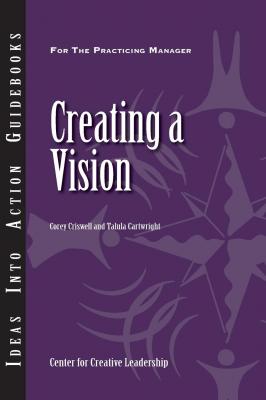Creating a Vision. Corey Criswell
Чтение книги онлайн.
Читать онлайн книгу Creating a Vision - Corey Criswell страница
 tion>
tion>
AN IDEAS INTO ACTION GUIDEBOOK
Creating a Vision
IDEAS INTO ACTION GUIDEBOOKS
Aimed at managers and executives who are concerned with their own and others’ development, each guidebook in this series gives specific advice on how to complete a developmental task or solve a leadership problem.
| LEAD CONTRIBUTORS | Corey Criswell |
| Talula Cartwright | |
| CONTRIBUTORS | Anand Chandrasekar, Craig |
| Chappelow, Michelle Crouch, | |
| David Loring, Ellen Van Velsor, | |
| Philip Willburn, Meena Wilson, | |
| Jeffrey Yip | |
| DIRECTOR OF ASSESSMENT, TOOLS, AND PUBLICATIONS | Sylvester Taylor |
| EDITOR | Peter Scisco |
| ASSOCIATE EDITOR | Karen Lewis |
| WRITER | Rebecca Garau |
| DESIGN AND LAYOUT | Joanne Ferguson |
| CONTRIBUTING ARTISTS | Laura J. Gibson |
| Chris Wilson, 29 & Company |
Copyright © 2010 Center for Creative Leadership.
All Rights Reserved. No part of this publication may be reproduced, stored in a retrieval system, or transmitted, in any form or by any means, electronic, mechanical, photocopying, recording, or otherwise, without the prior written permission of the publisher. Printed in the United States of America.
CCL No. 447
ISBN No. 978-1-60491-075-9
CENTER FOR CREATIVE LEADERSHIP
AN IDEAS INTO ACTION GUIDEBOOK
Creating a Vision
Corey Criswell and Talula Cartwright
THE IDEAS INTO ACTION GUIDEBOOK SERIES
This series of guidebooks draws on the practical knowledge that the Center for Creative Leadership (CCL®) has generated, since its inception in 1970, through its research and educational activity conducted in partnership with hundreds of thousands of managers and executives. Much of this knowledge is shared—in a way that is distinct from the typical university department, professional association, or consultancy. CCL is not simply a collection of individual experts, although the individual credentials of its staff are impressive; rather it is a community, with its members holding certain principles in common and working together to understand and generate practical responses to today’s leadership and organizational challenges.
The purpose of the series is to provide managers with specific advice on how to complete a developmental task or solve a leadership challenge. In doing that, the series carries out CCL’s mission to advance the understanding, practice, and development of leadership for the benefit of society worldwide. We think you will find the Ideas Into Action Guidebooks an important addition to your leadership toolkit.
Table of Contents
Vision and Effective Leadership
EXECUTIVE BRIEF
If you want to be an effective leader—at any level—you should pay attention to vision. Leaders who communicate a strong vision are seen by their bosses and coworkers as more effective in several important areas than those who do not. The content of your vision affects employees’ perception of your organization. Your articulation of the vision affects their perception of your leadership effectiveness. Taken together, vision content and vision articulation give your employees, colleagues, and other stakeholders a powerful image of how good your organization is and how skilled you are as a leader.
Vision and Effective Leadership
If you’re not a CEO, top executive, or business owner, you might not spend much time thinking about vision. You’re busy managing others, delivering on goals, implementing specific tactics, building a team, or focusing on financial performance. Creating a vision is not your priority.
But if you want to be an effective leader at any level, you should pay more attention to vision. Center for Creative Leadership (CCL) research suggests that leaders who communicate a strong vision are seen by their bosses and coworkers as more effective than those who do not (Willburn, Hackman, & Criswell, 2008; unless otherwise noted, all mentions of research in this guidebook refer to this study).
The research also shows that the content of a vision—the information itself—affects employees’ perception of the organization. Your articulation of a vision—how you communicate the information—affects employees’ perceptions of your leadership effectiveness. Taken together, vision content and vision articulation give your employees, colleagues, and other stakeholders a powerful image of how good your organization is and how skilled you are as a leader.
Whatever your leadership role—manager of a small staff, project manager, department head, or up-and-coming executive—developing a vision is a powerful tool for achieving your goals.
Demystifying Vision
The process of creating a clear and compelling vision is not widely understood. At the organizational level, a team or task force may be deployed to create a vision statement and communicate it throughout the organization. The team members may revise a current vision statement or pull together input from a variety